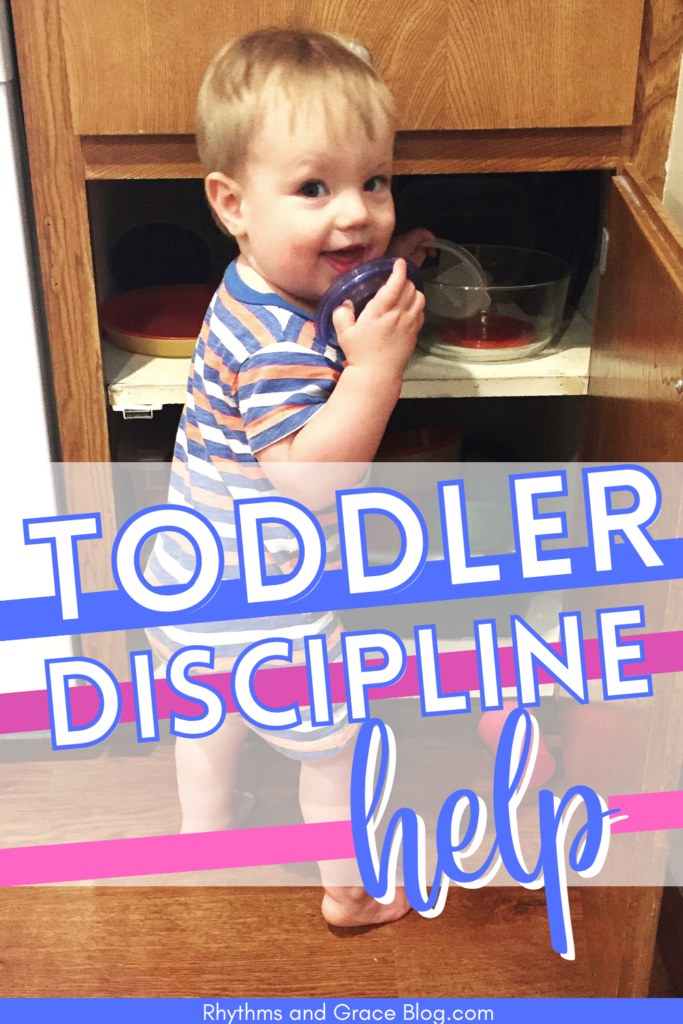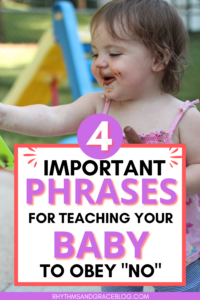Some of the links on this page are affiliate links. When you make a purchase through an affiliate link, I earn a commission at no cost to you. See my entire disclosure policy for all the boring details.
Ahhh one year olds. They’re cute, giggly, chubby, and opinionated. One minute they’re being gosh-darn-adorable and the next minute they’re throwing themselves on the floor screaming because you won’t let them stick their fork in the outlet.
It’s hard to be one.
My most strong willed child (and perhaps our brightest one) would actually pause his tantrum, walk 15 feet out of the hard-floored kitchen to the carpeted floor and then throw himself on the ground, flailing & crying.
So, yes, temper tantrums are normal for 1 year olds. On the other hand, I firmly believe (and have witnessed) that even those bright kids with strong personalities can learn to listen & obey parents when they say, “no.”
And that process for teaching your child “no” is exactly what I’ll cover in this post!
Note – here is another post with a more general philosophy of toddler behavior & discipline that be helpful to read before or after this one.
My husband and I had 4 kids in 5 years. So, we had a toddler around for a long time. We used four key phrases that all work together to teach obedience to our younger and older toddlers alike! We start this process around 9-12 months old… as soon as the child is old enough to crawl over and do something dangerous like throw a glass lamp on the floor.
Phrase #1 for 1 Year Old Discipline: “That’s a No.”
This simple phrase is one of the biggest hacks for teaching your 1 year old“no.”Using “that’s a no,” instead of just “no” is the best way to help a young toddler understand what is an unwanted behavior!
It might feel awkward at first to say, “That’s a no” instead of just, “No.” But as I got used to saying it, I liked it better than ‘no,’ because it is more specific.
This phrase first comes in handy when your newly crawling 8-10 month old starts exploring.
We prefer to make our house relatively toddler-exploration friendly and intentionally teach a few specific things/ places are off limits.
Cords are the first thing all our kids have gone for. They’re just so dangly and enticing. Cords are the perfect teaching opportunity for “that’s a no,” because:
- They’re everywhere – it’s nice for a toddler to learn “that’s a no” if you’re going to have to police it at other places too.
- They’re obvious & hard to hide or put away.
- They’re slightly dangerous (a child could pull something heavy over) but not life or death.
- They’re not that fun… by saying “no” to a cord, you’re not depriving the child of some awesome level of fun. Cords are nowhere near as fun as, say, emptying the tupperware drawer. Which is a definite “yes” activity in our house!
How exactly to teach your 1 year old “no” with the phrase, “that’s a no!”
This might not need explanation, but, we are pretty deliberate with how we teach this, so, in the spirit of oversharing, I thought I would give you a step by step for how using this phrase to teach your 1 year old“no” might look. You’re the parent of your child though, so adjust the process as works best for your family. (Make sure you and your spouse are on the same page!)
- The 9 month old crawls towards the enticing dangly cord hanging from the end table.
- As soon as she touches it or reaches for it, I clap loudly (to get her attention/ break her focus) and say firmly “Emma, that’s a no” while pointing to the forbidden
fruititem. (You can use a stern voice without harshness or shouting.) - I often repeat again with the name of the item inserted, “The cord is a no.”
- Then I bring her away from it and distract her with something else. I carry her away facing away from me and put her down on the ground across the room. (Like a mini time out.)
As I’m first introducing this phrase, I would stay sort of near by but pretend like I’m not paying attention. I’d fold laundry or read a book or something. Basically, this gives the toddler a chance to decide if she’s going to try again. If I’m nearby, I can more easily respond quickly & consistently, which helps, a lot!
Be careful not to make it a game where you’re chasing them toward the charger for fun! It’s hard not to turn it into a game because they’re so dang cute. But do not say, “No No No” in a sing songy lovey voice. That will confuse your child. More about that in a minute…
When baby first starts crawling, you are just teaching him or her what this phrase means and how to listen to that firm tone of voice from a very young age.
You don’t have to apply ‘that’s a no’ to every single off-limits thing right away and you need not expect perfect obedience. LOL. It’s literally just a teaching tool. We kind of informally & accidentally picked cords as the first thing we taught ‘that’s a no’ with because they are everywhere, at our house and other people’s houses, and they’re semi-dangerous.
With most other items I didn’t want a 1 year old playing with, I’d just move those items out of reach, or say “that’s a no” one time and then move the objects out of reach. There are a few weeks where your child is pulling up on furniture and cruising around. That’s a great month to remove the beautiful coffee table books & decorations. You can put them back eventually and teach the child “that’s a no” for all that stuff.
But at first, it’s nice if you don’t have to monitor the busy giant baby all the time. It’s tiring and unnecessary to try to monitor every single off-limits thing at this age, so we focused on one thing (cords) to teach this concept of listening and obeying the phrase “that’s a no.”
What if She Does it Anyway? Young Toddler Discipline Tips
Effective discipline comes down to meaning what you say and saying what you mean. If “that’s a no” means “don’t do that,” and the child does it anyway, you have to respond with a negative consequence or the child will not learn what “no” means.
My all time favorite book to recommend to parents of 9-28 month olds is “Making the Twos Terrific,” by John Rosemond. As a child psychologist and counselor, he has decades of research and work with children and parents under his belt and clearly articulates why and how to set the stage for happy obedient children, beginning in the earliest years. It’s funny, encouraging, and practical! I’ve read it a few times and highly recommend it to everyone. If you need more practical tips than this blog or you want to think about your overall game plan, it’d be a good idea to grab this book.
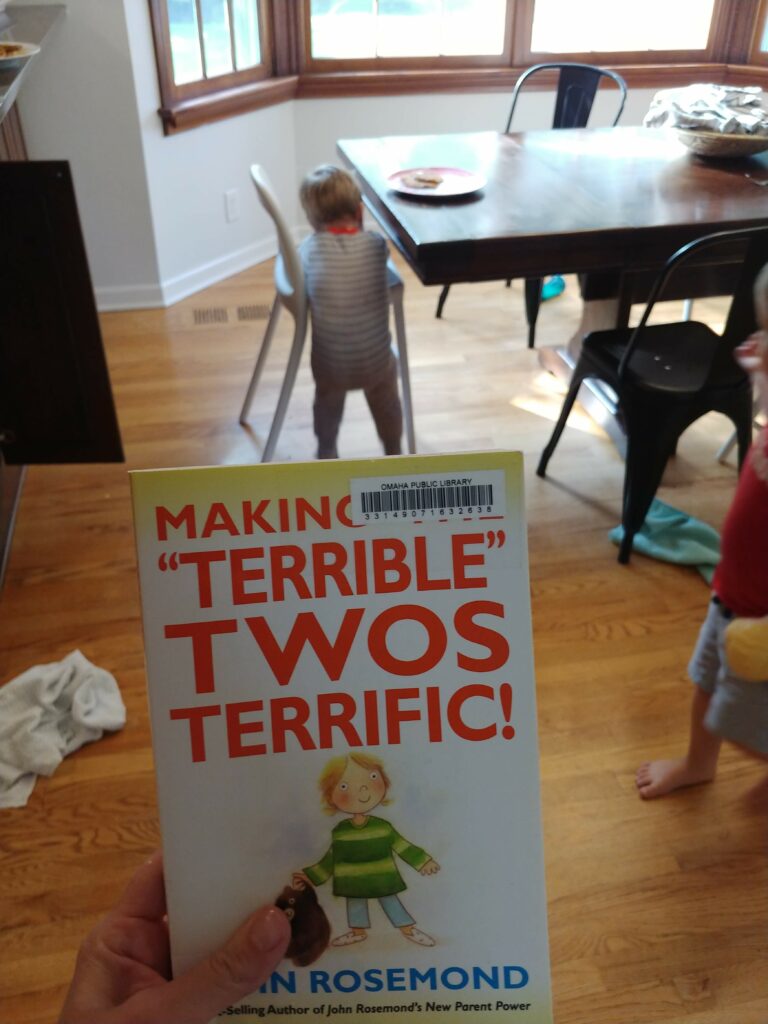
Some practical guidelines for effective toddler discipline are:
- Don’t say “no no” in a sweet sing song voice.
- Don’t say “no” from far away. You have to go over to the child, make eye contact and say firmly “that’s a no.”
- Don’t say “no” if you aren’t willing to respond the first time, and take the object or the child away. Be firm, clear, concise.
- Follow through quickly. If you say no, and the child goes for something, you have to respond calmly & immediately. You don’t need to have power struggles with your 1 year old. You’re the parent and the adult. You can remain calm but firm.
- Don’t have a “next time you do this, then I’ll act” mantra.
- Pick and choose what is off limits. Children thrive when they can safely explore their environments. If you set up your home in a way that requires you to constantly follow your one year old around, he will be frustrated & you will be exhausted.
- Parents are in charge in the home – be the loving authority.
Negative and Positive Reinforcement
The specifics of disciplining a 1 year old and enforcing“that’s a no” will vary based on your parenting styles, and your child’s personality.
A 1 year old isn’t old enough to have a behavior chart. “Good behavior” isn’t even really the goal at this age… it’s more about establishing that Mom & Dad are in charge, no means no, and understanding what’s off limits and what’s not. Behavior charts aren’t even developmentally appropriate for most 2 year olds and 3 year olds. It’s much more effective in the long run to just teach young children that no means no, while also giving the child lots of freedom to explore & play at home freely.
But how? Well…
We have 3 children who were relatively compliant around this age (and one who was not).
For the compliant children, my first step was usually to clap loudly and use my firm mommy voice to say, “THAT’S A NO.” (not yelling – just a firm tone)
Then, I moved them away from the off limits situation and put them on the ground across the room, and they promptly burst into tears. (Almost like a mini time out.)
Or, they might not cry, but that momentary “separation” basically did the trick.
Consistently saying no firmly, and moving them away from me was enough to cause them“pain…” They now associate the phrase“that’s a no,” with displeasing Mom and realize that they don’t want to do that.
After 10 seconds, I always scoop the child up, smile, go back over to the off limits item and say, “That’s a no. No cords. Listen and obey mommy. I love you. ” Then I take her to play elsewhere or distract her with something else.
I also had a less compliant child who, in the same scenario, smiled and turned around and went right back towards the same object, smiling at me the whole time. Daring me to mean what I said. At the ripe old age of 14 months! (Perhaps you can relate!?)
Some people call this a strong willed child. 🤪 The amount of determination “strong willed children” have, of course, varies from child to child.
For any repeated, clear disobedience like that, I always immediately said, “That’s a no,” in a very stern, firm voice, moved the child to sit in a corner on the floor nearby for about 10-15 seconds, and turned around or walked away. The child usually looked startled. I would replace them if they tried to crawl away. Eventually they figured out this is time out.
Here’s why we were okay with this in our home: effective discipline is a combination of CLEAR BOUNDARIES + EXPLANATION + PAIN + LOVE.
You can read our family’s parent-led home philosophy in detail, but I’m a firm believer in consistent boundaries.
The 10-30 second “pain” of time out for a 1 year old is much better than the pain of, say, pulling a heavy lamp on top of your head or getting electrocuted from sticking a fork in the outlet… a know!? Setting and enforcing reasonable boundaries is loving.
A parental authority who sets boundaries for their children so that they can freely & safely explore within those boundaries is creating a safe and secure home environment.
A compliant 1 year old will learn this VERY quickly. A strong-willed 1 year old will take more time. But if you are clear and consistent, all children will learn!
Don’t Discipline for Childishness
They’re 1, for goodness sake. Do not make every single thing in your home a “no.”
Your one year old is going to empty all your drawers and cabinets, climb the stairs, explore and touch and eat everything… And if your older toddler leaves water out, your younger toddler will dump it all on the ground.
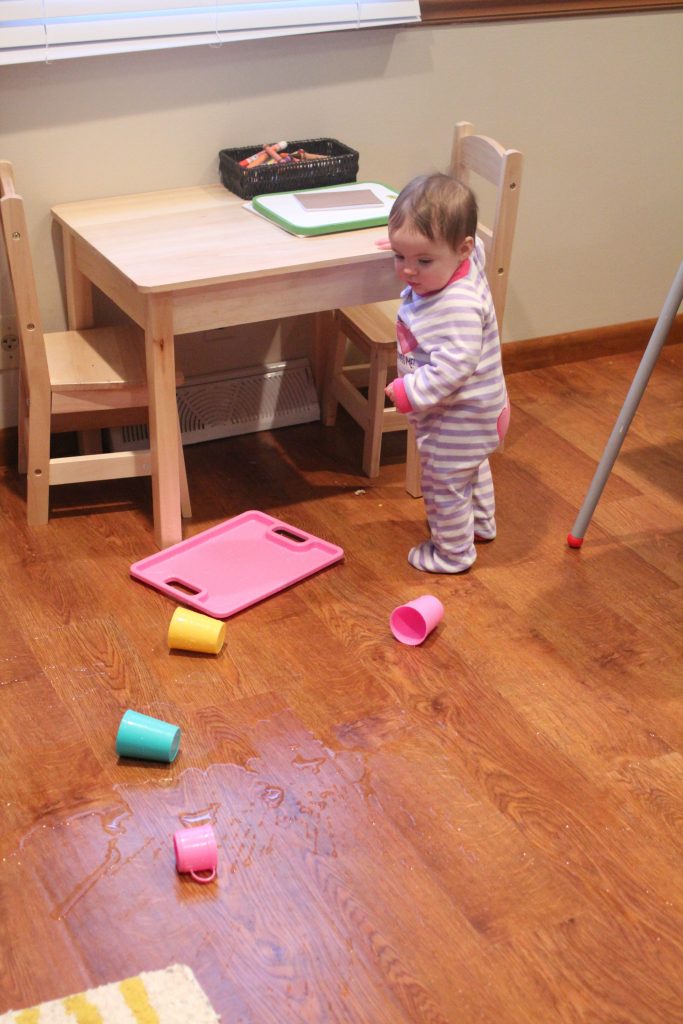
Baby Proofing + Proactive “Discipline”
Part of effective discipline is creating a safe environment for the child to explore.
While I don’t do the whole-house extreme cabinet locks everywhere baby proofing, I do take some reasonable measures to make sure our home is a safe area for all our kids to enjoy, including the toddler. Toxic cleaning products, glass dishes, and knives are out of reach. I keep the doors to the basement stairs and bathrooms closed. I don’t let our 1 year old wander around in the front yard and I don’t expect our brand new toddling 13 month old to stay next to me in the parking lot… I just hold her.
As I mentioned, I do move a lot of things out of reach because it’s not worth dealing with every single little thing being off limits.
Use common sense to avoid a dangerous situation while still making sure your child can play all over your home. Freedom to explore and engage in unstructured play is essential to a child’s brain development. Babies are forming new neural connections all the time and they have to be able to experiment around the house with both child toys and household items.
Phrase #2: “Shake Shake Shake”
Another thing we noticed about the word “no” is that you can teach your baby “no” about the same time they start to shake their head back and forth (like you shake your head, “no”).
The problem with this is, the head shake is super cute! And they love to play the shake-your-head game.
BUT if you associate the shake-your-head game with the word, “no,” then when you say, “that’s a no,” they’ll cutely shake their head no! Like it’s a game.
What we’ve done to be consistent and clear is use the phrase“SHAKE SHAKE SHAKE” for the head shaking game and stick to“that’s a no”(in a firm voice) for teaching“no.” Right around the first year is the best time to teach other sign language too, such as signs for more, please, thank you, hungry, water, etc.
The point of playing shake shake shake is to teach your child the difference between head shaking as a game and understanding when you’re serious about“that’s a no.”
Joking is fun & we joke with our kids all the time! Just not about the word “no” at 10 months old, right when they’re first learning what “no” means.
Here’s an example of the joking we try to avoid:
Chasing them as they crawl toward the laptop charger or outlet or fan or whatever because everyone is smiling and giggling as you say “no no little sugar plum…”
This makes it really hard to make your “no” mean NO for real 5 minutes later.
If your 1 year old doesn’t listen or obey you at all, pay attention to whether you accidentally use the word, “no” as a joke sometimes.
We do the fun crawling chasing game all the time still because it’s one of those fun activities all toddlers love! We just don’t use the word “no” in the game at this age.
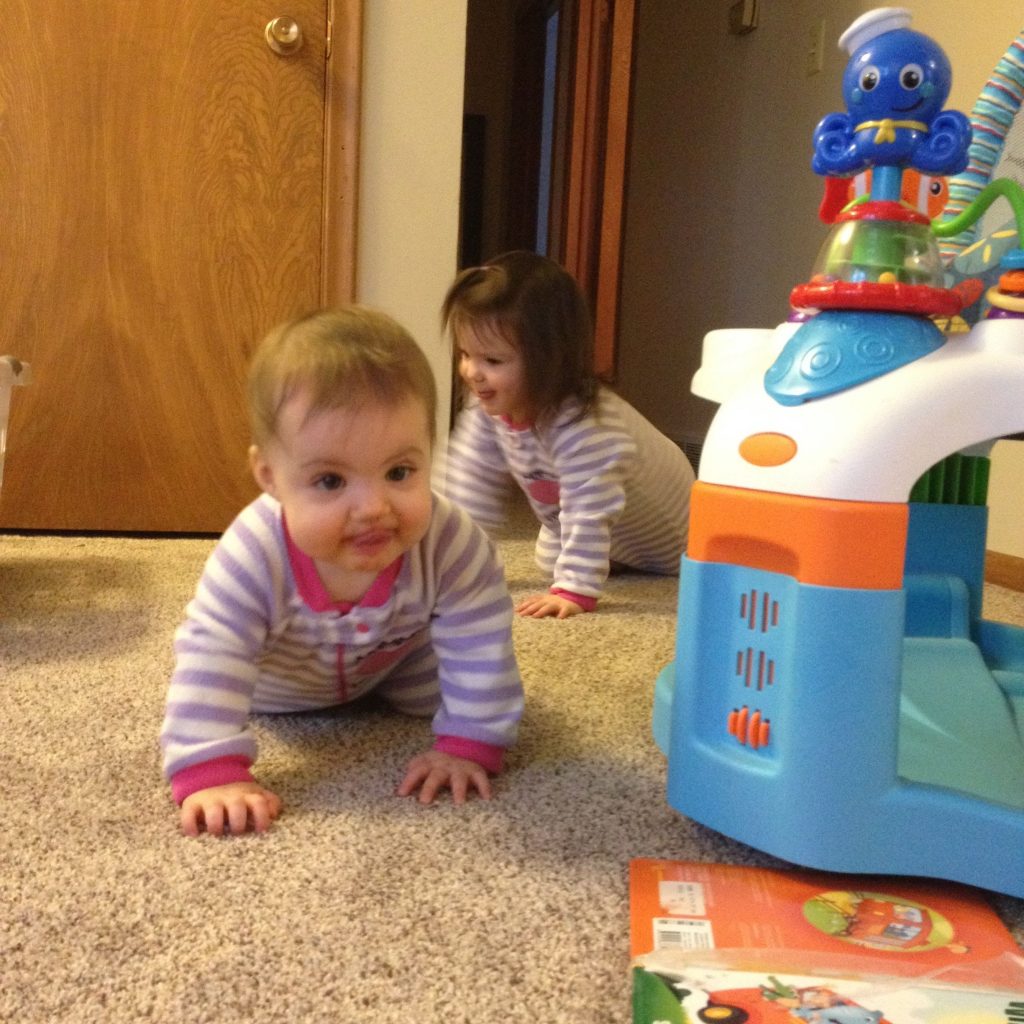
We do joke about“no” as the kids get older!
Our 2-6 year olds love asking something outrageous and hearing me laugh and say, “No way, José!”
As a general rule, an older child (age 2-3 years old) can understand teasing sarcasm more. We’ll tease: “Don’t have any fun at Grandma’s house while we’re gone!!” And our kids will laugh and respond, “We will! we will!”
Or we’ll say, “You better not eat your veggies!!” And they’ll laugh and say, “I’m going to!!” (How’s that for awesome reverse psychology? haha!)
The point is… once the boundaries are clear, and they can tell what“no” means and that you are in charge and you mean it when you say,“no,” then you can joke freely.
BUT for the months where you are actually trying to teach your one year old, “no,” don’t mix up the word with any sort of game! It’ll make the training process easier.
Phrase #3: “Yes Mommy.”
In conjunction with teaching “that’s a no,” we also teach “yes mommy.”
Sometime around 8-12 months, your little one starts very cutely and deliberately nodding their head yes.
It’s harder for them physically than shaking their head no. Once baby can nod, I say “yes” a lot and nod with them so that they learn the nod means yes.
Sometimes I’ll play a game of going back and forth between nodding and shaking for the baby to imitate me:
- Baby shakes, I shake and say, “shake shake shake.”
- Then I nod, and say, “Yes, yes, yes.”
- And baby copies the nod, giggling.
- Sometimes we mix a peekaboo in here too! It’s all fun and for the point of associating head shakes with“shake shake shake,” and head nods with“yes.”
It doesn’t take long for baby to associate the head nod with “yes.”
Once they understand it means yes, we add the head nod “yes” to the whole ‘that’s a no’ situation.
How to Teach Yes Mommy!
I’ll say, “that’s a no… no cords. (Pause) Say yes mommy.” Then I’ll nod with baby and say “yes mommy,” (I just say it as if the baby is responding. Demonstrating what I expect.)
The idea is that they nod to symbolize they understand that you are telling them something. Introducing“yes mommy” super early on will pay off BIG TIME in the“terrific twos…” which will be all the more terrific because you started teaching your child to obey when she was one!
The baby may not actually nod at the right time for a long time… that’s okay! Just do it anyway. They’ll catch on.
At first, it’s all just instilling the habit. The true understanding comes a bit later.
Our second daughter was around 13 months when she started nodding almost every time we said, “Say yes mommy.”
That doesn’t mean she obeyed perfectly… obviously! It’s just our way of instilling the habit of her responding when we tell her something. This way, when she turns 2 and we’re going on a walk, I can say, “you need to stay on the sidewalk and not go into the street” and she says “ok mom” and I know she gets it.
As your toddler acquires grows in language development, the “yes mommy” will likely go from a head nod to words. It was later for my 3rd son…. all his words came a bit later than our first two kids.
Once the child has built the habit of acknowledging when they hear you and understand you, it’s easier to identify and distinguish between when they’re going against what you’ve told them, and when they just don’t know any better.
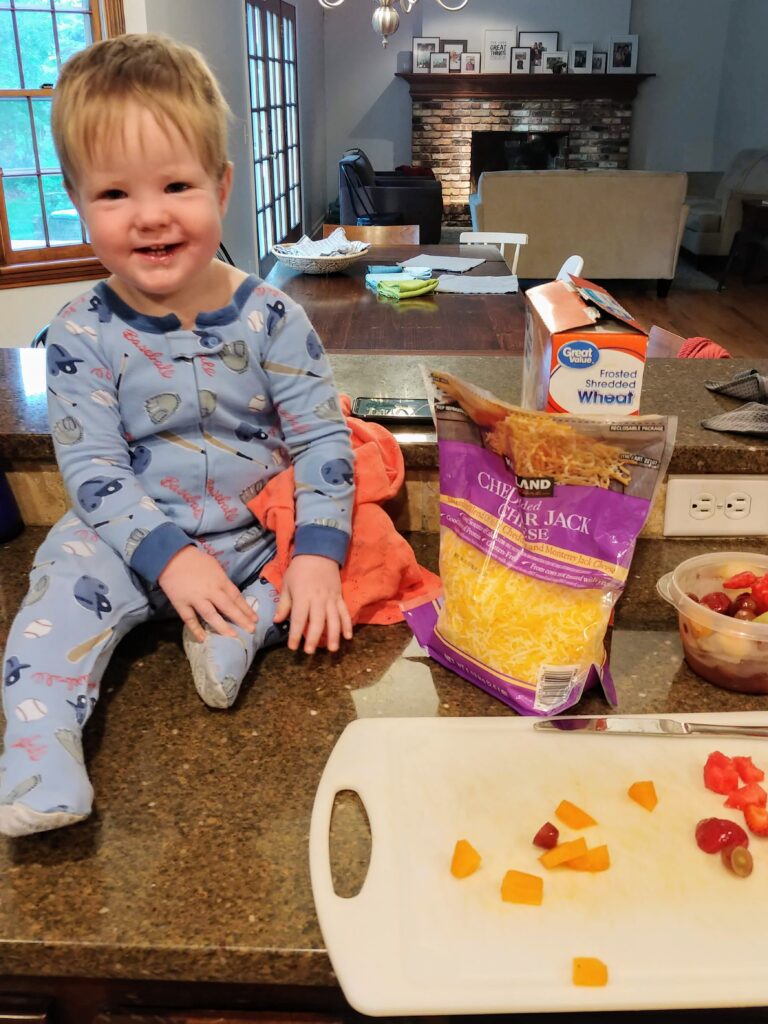
Phrase #4:“Listen and Obey”
This is another one that felt awkward at first. I don’t know if the word obey is old fashioned or feels culturally unacceptable or what, but I used to find myself slightly self-conscious using it in front of people.
7 years and 4 kids later, I’m basically over that. “Listen and obey” rolls off my tongue any time, any place.
The idea behind “listen AND OBEY” (as opposed to just “listen to me”) is that your child can listen and choose not to obey.
How to introduce and teach“listen and obey” during the toddler years
“Listen and obey” is easiest to teach when you can help them obey. You’re not expecting obedience, really. You’re just demonstrating the concept of what “listen and obey” means. This is one of my favorite positive discipline techniques.
Example 1 : Teaching Clean Up Your Toys
You can say “it’s clean up time, put the toys in the basket,” then you basically put all the toys away and guide the 12 month old’s hands to drop the toy they’re holding in the basket.
While helping them do all the work you say, “Good job listening and obeying Mommy. Clean up time! Great job!” It doesn’t take much time to work on this concept, but you’ll want to repeat the situation often so that the child learns.
This is a great way to teach the concept of ‘listen and obey’ as a positive thing. You are being a role model, demonstrating the right thing, and using simple words to show clear expectations. I’m all about the positive reinforcement whenever possible!
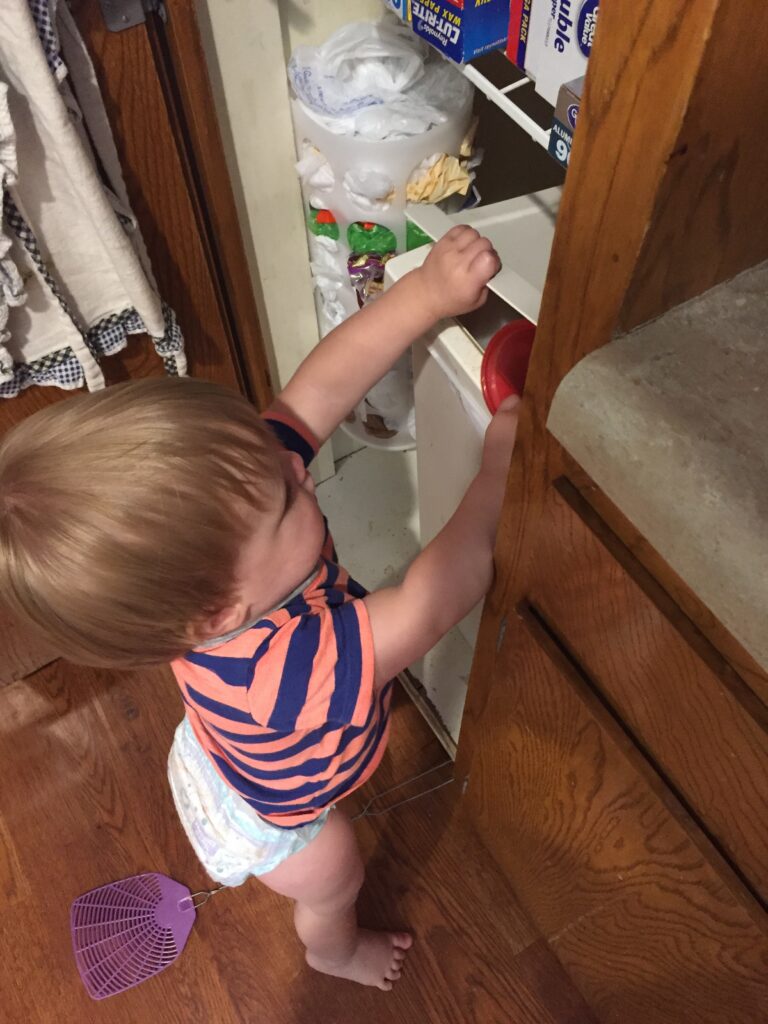
Example 2: Throwing Food
I worked on “listen and obey” with our second child around 14 months of age. By that age, she totally understood we didn’t want her purposefully throwing food on the floor. (This may not be one of your family rules… that’s okay! You can teach it in any situation you’ve decided to set limits in.)
During a meal, when I handed her the plate of cut up food, I’d say “Emma, there is no throwing food on the floor on purpose. Say yes mommy.” (I’d nod my head and answer myself, yes mommy.) She eventually mimicked my nodding for “yes mommy.”
I’d purposefully seem distracted (getting something else for the table or eating myself) but also be subtly paying attention. Then I’d notice she seemed to be thinking about throwing food, I’d reach over to help her put it back on the plate and say, “Good listening and obeying, Emma!! Yes, your food stays on the plate. Not on the floor.”
The older siblings usually get excited too and cheer the little ones on.
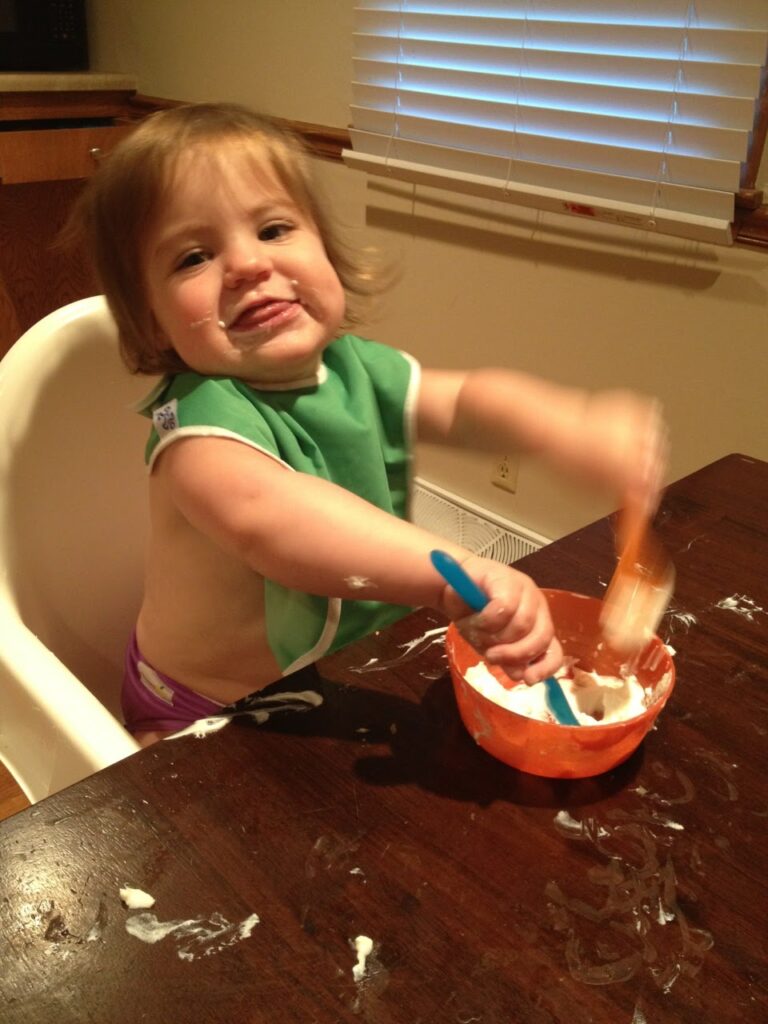
As your one year old learns more words, she’ll be able to say the word ‘obey.’ At some point, our kids got old enough (around 2 years old) to where we would say “you need to listen and _____,” and each child would sort of automatically fill in the blank with “obey!” because they’d been hearing the phrase for a while at that point.
It’s kind of synonymous with a‘yes mommy.’ Some sort of acknowledgement of their understanding.
I still use it all the time with my big 3 at ages 2.5, 4.5, and 6! Often more of a reminder. When I can see one of them teetering on the edge of disobedience, I just quietly remind her/him, “Listen and….” and much of the time, they’ll say “obey” and comply.
(Notice I didn’t say they comply all of the time.)
There are no perfectly behaved toddlers.
Hear me on this, moms and dads. Our kids aren’t perfect.
- Perfection is not the goal. Good behavior all the time isn’t the goal either. Eventually, there will be lots of opportunities to preach the gospel to your kids in their moments of sin. To show them their behavior reveals their heart and that
whatwho they really need is Jesus. There will be many opportunities for you to apologize and show them Mommy needs Jesus too.
But when your child is 1, focus on teaching your 1 year old to obey. It will set the stage for all the other, more important stuff as they get older.
A few more FAQs and Related Notes
BOOK RECS – Adopting a parent-led home philosophy makes a huge difference. In addition to that John Rosemond Twos book, I’ve also found the following parenting books helpful for the early years: M is for Mama, Parenting by the Book, Sleep Training eBook (mine!)
SCREEN TIME SOAP BOX – Despite all the early childhood educational apps marketed at parents, most research has concluded that at the end of the day, a young child’s brain does not respond positively to any screen time on a tablet. The little bit of educational benefits (learning to count or sing the alphabet) are not worth the damage. Plus those things can easily be taught without technology. Once you do a little digging, it’s hard to ignore the negative consequences on your child’s feelings, problem-solving skills, social skills and language skills. I used to let my first child play little counting games on my phone when she was around 20 months. It turned her into a monster, so we cut touch screen time cold turkey 100%. It was hard for like 2 weeks, and that was it. I have found having a zero tablet time policy is one of the most simple strategies for encouraging imaginative play, pretend play, proper behavior, and hand-eye coordination. I know it may sound crazy and completely against the norm, but I promise your young children will be happier and better at playing independently if you cut touch screens completely.
Related Posts
- Free & Cheap Independent Toddler Activities – Keep ’em Busy!!
- More activities – geared towards 13 month olds
